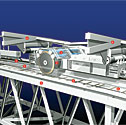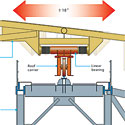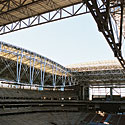Stadium Roofs Offer Much More Than Shelter
The construction and design team decided to build the roof assembly on the ground early in the design process, allowing incorporation of several features in the structure to facilitate the lift. For example, the supercolumns are C-shaped in plan and have 15-foot-wide slots through which the roof structure bearing was lifted.
In addition, because the 156-foot-tall supercolumns were required to perform the lift, they had to be built before much of the seating bowl, and to withstand the forces of the jacking process. "We needed to consider the supercolumns as freestanding elements and had to consider them at every stage [of construction] for stability," says Dean Purdy, president of TLCP Structural, engineer for the concrete stadium. "The critical design considerations were the forces and moments imposed at the top of the supercolumns due to jacking."
The 500,000-square-foot roof consists of two 87-foot-deep, lenticular-shaped Brunel trusses that span 700 feet. Spanning between these are eight Vierendeel trusses for each of two operable panels that bi-part to create a 240-foot-wide-by-360-foot-long opening in the roof. The Brunels support three fixed trusses at each end of field. Five secondary trusses on each side of the field span from the Brunel to perimeter.
In spite of its name, the Brunel is not technically a truss, according to Mark Waggoner, an associate with Walter P Moore, the roof's structural engineer. Instead, the top chord works much like an arch, with constant compression along its length. The bottom chord works like a catenary cable to carry constant tension. "When combined, they create a system that works efficiently and requires only slender struts between them, versus the heavy diagonal elements of a traditional truss," he says.
The roof has two retractable panels, 185 feet long and 285 feet wide. Each panel is supported by eight sets of "carriers," or wheeled transporter assemblies, controlled by four, 71¼2-horsepower motors. These ride on crane rails that sit on top of the Brunel top chords.












